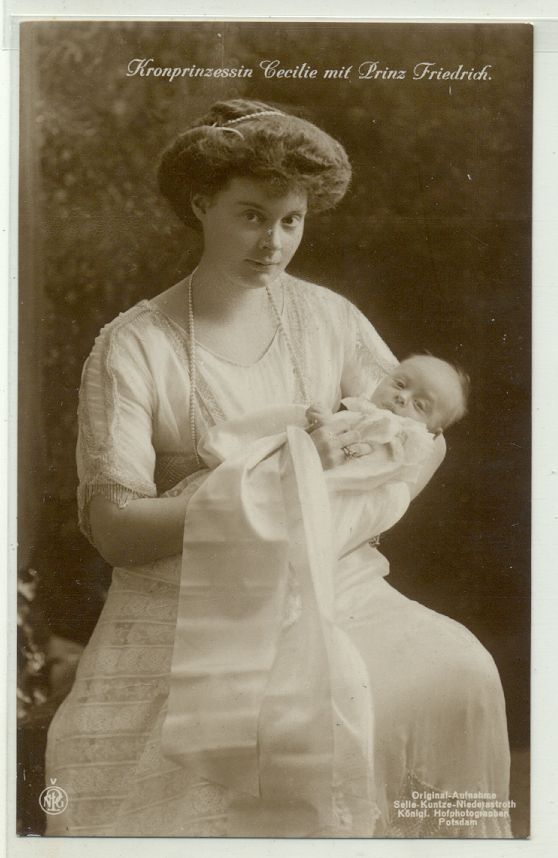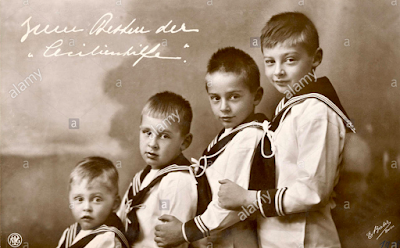 |
| El príncipe Federico de Prusia en 1922 |
Nacido en Berlín el 19 de diciembre de 1911, el príncipe Federico Jorge Guillermo Cristóbal de Prusia fue el cuarto hijo del príncipe heredero alemán Guillermo y su esposa Cecilia (de soltera duquesa de Mecklemburgo-Schwerin).
 |
| El príncipe Federico de Prusia en la década de 1930 |
Ayer llamó Fritzy para decirnos que su madre, la Princesa Heredera, nos esperaba para almorzar hoy y que nos preguntábamos qué ponernos para este compromiso real.
I thought that grey flannels would be appropriate for lunch in the country anywhere, but, on the whole, we decided black might be more correct and so black it was, with Harold Balfour and I in our House of Commons uniforms, and Honor beautifully dressed in semi-grand ‘dayers.’ Cecilienhof, which the Imperial Family thinks looks very English, is a dreadful Lutyens sort of house, ugly and bogus Tudor, built just before the war. That it overlooks a lake is its only consolation. Fritzy met us and led us to the water’s edge, where we found Princess Cécile, his second sister, an intelligent, half cross-eyed girl of eighteen, bathing with young Lord Jellicoe. The house itself is very royal with plush, palms, bareness, and faded, signed photographs of dead monarchs. Fritzy showed us his mother’s bath-cum-dressing room, which she has fitted up as a yacht, to remind her of Kiel, and we were laughing a little, when the door opened and the Crown Princess walked in, large, smiling, and gracious. ‘Thank you so much for all your kindness to my child,’ she said to the curtseying Honor. She looked very, very royal, with gold, jingling bracelets, large single pearl earrings, simple clothes and a Fabergé brooch. We filed in to luncheon in a large dining room and Honor was between the two princes, I on the right of the Crown Princess. She is indeed very much a Mecklenburg, that is, dark and rather Russian (she is a double first cousin of my adored Princess Nicholas, whose mother, the Grand Duchess Vladimir, was a Mecklenburg). All the Mecklenburgs have a frivolous outlook and are dark, charming and well-bred. Princess Marina, for instance. They all have a habit of talking in a slightly guttural voice, and their catch phrases are ‘poor thing,’ ‘do you find,’ and ‘it makes me the impression.’
 |
| The Duke and Duchess of Sutherland |
The Sutherlands’ Ball. A dazzling night. Honor looked magnificent with all her sapphires, tiara and a resplendent blue brocade number made to match the Amalienburg and we were hardly dressed and down before the brace of young princelings, Ernst August of Hanover, and Fritzy of Prussia, very young, fair and Nordic and dripping with decorations, arrived almost too punctually. Soon after nine we swept into dinner, and the dining room was a gorgeous, glittering sight of jewels shimmering in the candle-light, of Meissen china, of decorations and splendour. Mrs Grenville was delighted to be next to the young Prince of Prussia and there was great stimmung and excitement. At 10.45 Honor and I with Ernst August, jumped into our car, and armed with a special white card we drove to the Royal entrance – rather to everyone’s annoyance, at Hampden House. The Ball was the best spectacle so far of the summer; we were ushered into an improved ballroom hung with tapestries, with, at one end, an enormous dais of red baize where all the Royalties of the earth seemed congregated. We had barely arrived when the King and Queen entered with the Sutherlands. All four were gay, smiling and impressive, and I noticed how both the King and Queen have gained greatly in presence and dignity. They went up to the queue of Royalties and greeted them all, kissing many. The Queen was in white, with an ugly spiked tiara, and she showed no sign of her supposed pregnancy, which I am beginning to doubt. The King followed her, showing his teeth. Queen Mary was in icy blue; soon the ball began. Honor and I were dancing near the dais when we caught Queen Mary’s eye, and we stopped to curtsey and bow as she held out her hand. Then Honor and I became separated and I danced with Lady Iveagh. Later I danced with Alice Hofmannsthal, and we went up to the dais to talk to Princess Olga who was wearing her mother’s ruby parure. We chatted with her for a few minutes, and as we turned we saw the King and Queen coming up to us, and they very smilingly talked to us. Both Alice and I were thrilled, which was unreasonable as we have both known them for years, and at one time intimately.
 |
| Friedrich’s father German Crown Prince Wilhelm with Adolf Hitler |
Fritzi of Prussia, who is staying here told me today that Hitler dined quietly some years ago at Cecilienhof with his parents, and that he had sat on a sofa after dinner, and had solemnly declared that it was his intention of restoring the German Monarchy directly he could. They believed him, and indeed perhaps he meant it, at the time. Perhaps he meant it altogether. Fritzi also told me that he had no intention of fighting for the Nazis, whose régime he thinks not only repugnant but doomed.
 |
| Friedrich of Prussia |
Fritzi of Prussia came to see me, and told me of his engagement to my sister-in-law Brigid [Guinness]: I am entranced, and was so moved that in a sad flash I remembered the days when we were all so happy, and did not know it.
 |
| Prince Friedrich of Prussia and Lady Brigid Guinness after their wedding |
 |
| Brigid and Friedrich of Prussia |
 |
| The wedding of Duke Carl Gregor and Princess Maria Margarethe of Hohenzollern takes place as planned |
 |
| Article from the Philadelphia Inquirer that appeared on 27 April 1966 |
 |
| Princess Antoinette of Croÿ, the last person to speak to Friedrich, seemingly disappears |
On Saturday, 30 April, eleven days after he went missing, it was reported that Prince Friedrich of Prussia had visited Frankfurt’s police headquarters to register as a resident earlier on the very day that he later disappeared. Further, it came to light that Princess Antoinette of Croÿ (1915-2011), who was the last person to speak to Friedrich on the phone on 19 April, had also apparently vanished; although, it must be said, that the princess’ housekeeper stated that “she [Antoinette] simply went on vacation,” which was likely the case, as the princess later returned from wherever she went. Before she left, Antoinette had told the Hohenzollern family that Friedrich had mentioned nothing to indicate what was to come during their telephone call, and that the pair had agreed to meet during the weekend – at which time the prince did not show up. The papers also learned that the divorce action between Friedrich and Brigid of Prussia was supposed to be heard by a Frankfurt court on Tuesday, 3 May; however, given the circumstances, it was confirmed that the case would be delayed if the prince was not found before then.
Police announced Sunday they have found the body of Prince Friedrich of Prussia, grandson of Germany’s last kaiser, who had been missing since April 19.
They said the body was recovered from the Rhine River near this town 18 miles downstream from the Reinhartshausen Schloss Hotel where he vanished on a midnight walk. The prince owned the hotel, a converted castle only 50 yards from the edge of the river at Erbach.
SUICIDE POSSIBLE
Chief Prosecutor Hans Klein, in charge of the investigation, said the situation “appears to indicate suicide but there is no definite evidence. The official cause of death has yet to be determined.”
The 54-year-old prince, who had lived in England for most of the last 30 years, is survived by his wife Lady Brigid Guinness, and five children.
Last week, the chief investigator in the search for the prince said it had been confirmed that divorce proceedings to end the prince’s 20-year marriage to the Guinness brewery heiress were pending in Frankfurt. The first hearing was to have been held Tuesday in a West German court.
KNEW ABOUT WORRY
Prince Louis Ferdinand, oldest brother of the dead prince and chief of the house of Hohenzollern, was informed of the death. He said in a statement last week he knew his brother “was deeply concerned about something about which I and various family members of the family will give no information. It concerns a circumstance from which suicide appears to be excluded.”
El descubrimiento del cadáver se produjo después de que la policía interrumpiera la búsqueda. Durante más de una semana, decenas de policías, apoyados por helicópteros, habían rastreado los bosques que rodean el hotel.
ENCONTRADO POR PILOTOS
Tres pilotos que operaban embarcaciones entre este lugar y Lorelei Rock descubrieron el cuerpo, que estaba completamente vestido. Unos gemelos de oro, con la corona de Prusia y las iniciales del príncipe, proporcionaron la primera pista sobre su identidad.
Friedrich George Wilhelm Christoph, príncipe de Prusia, era hijo del príncipe heredero Friedrich Wilhelm y tataranieto de la reina Victoria.
 |
| Anthony Patrick Ness en su juventud |












No comments:
Post a Comment